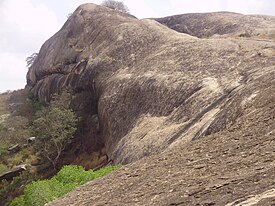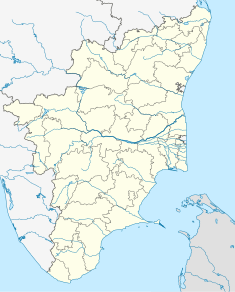| Sittanavasal Cave | |
|---|---|
 Sittanavasal Cave | |
| Location | Pudukottai, India |
| Coordinates | 10°27′16″N 78°43′29″E / 10.4544°N 78.7247°E |
| Built | Śramaṇa Period (Second century BC to 900 AD)[1] |
| Architectural style(s) | Pandyan |
| Part of a series on |
| Jainism |
|---|
 |
Sittanavasal Cave (also, Arivar Koil) is a 2nd-century Tamil Śramaṇa complex of caves in Sittanavasal village in Pudukottai district of Tamil Nadu, India.[2][3] Its name is a distorted form of Sit-tan-na-va-yil, a Tamil word which means "the abode of great saints" (Tamil: சித்தன்னவாசல்).
The monument is a rock-cut monastery or temple. Created by Tamil Śramaṇa, it is called the Arivar Koil, and is a rock cut cave temple of the Arihants. It contains remnants of notable frescoes from the 7th century. The murals have been painted with vegetable and mineral dyes in black, green, yellow, orange, blue, and white. Paintings have been created by applying colours over a thin wet surface of lime plaster.[3][4][5]
Ancient structures such as Gol Gumbaz, Talagirisvara temple and this one are claimed to be relatively unappreciated.[6] Archaeological Survey of India has listed Sittanavasal Cave in the list of "Must See" Indian Heritage.[7]
The Sittanavasal Cave are listed as one of the Adarsh Smarak Monument by Archaeological Survey of India.[8]
- ^ "Sittannavasal: relics from the 2nd century B.C." The Hindu.
- ^ "Rocky retreat". The Hindu. 25 October 2012. Archived from the original on 26 November 2004.
- ^ a b "S u d h a r s a n a m:A centre for Arts and Culture" (PDF). Indian Heritage Organization. Retrieved 26 October 2012.
- ^ "Sittanavasal – A passage to the Indian History and Monuments". Puratattva: The Legacy of Chitrasutra, Indian History and Architecture. Archived from the original on 14 August 2012. Retrieved 26 October 2012.
- ^ "The Ajanta of TamilNadu". The Tribune. Tribune, India. 27 November 2005.
- ^ Behl, Benoy K. (7 March 2014). "Appreciate the ancient". The Hindu. Retrieved 15 March 2014.
- ^ "Adarsh Smarak Monument". Archaeological Survey of India. Retrieved 2 May 2022.
